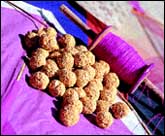


 Til Gul Ghya, Gaud, Gaud Bola!
Til Gul Ghya, Gaud, Gaud Bola!Makara Sankranti in January is best known as the Indian festival of kites. It signifies the start of harvest and is an occasion when food becomes a focal point. Especially the simple Til Gul Ladoo, writes CHITRA SAWANT. |
|
EVERY January 14, Maharashtra, Gujarat and Rajasthan celebrate Makara Sankranti, the day that marks the beginning of the northerly (uttarayan) journey of the sun... from the Tropic of Cancer to the Tropic of Capricorn. It is also the start of harvest in much of agricultural India, and the return of balmy days when the air is cold and misty. In keeping with the Indian tradition of food playing a central role in festivals, and the belief of "atithi devo bhava", which in Sanskrit means that a guest is equal to God and should be treated as one, special sweets are made from sesame (til) and jaggery (gur) to be distributed and eaten. Both are heat-producing ingredients. Ponkh (tender green millet) and Undhiyu (a beans and root veggie speciality) are the favourite foods of the people, Til Gul Ladoos of the Gods. And kite-flying competetions are organised to rally the people together and a feast is organised from the newly harvested food grains. Families exchange plates of warming, gingery sweets, and wish each other luck, prosperity and good health in the coming year. This is simply done by offering a plate of Til Gul Ladoos and saying, "Til gul ghya, gaud, gaud bola!" Which translated, literally means 'May you eat Til Gul and say something sweet!' Makara Sankranti is known around the world as the great Indian festival of kites. On this day, azure skies are emblazoned with a vivid burst of colourful kites of every pattern and dimension. Right from the night before, when people replenish their stocks of kites (patangs) and thread (manja), the excitement in the air is almost palpable. At the very break of dawn, the entire populace in cities like Ahmedabad, Surat, Jodhpur, Jaipur and even Bombay, moves up to their terraces and open maidans to participate in the very serious game of kite-flying and cutting down of rivals' kites. This is all conducted with almost martial determination. Rival kite flyers work themelves up into a frenzy in their fight for the skies. So engrossed are they in proving their aerodynamic skills, that they don't seem to notice the deep cuts the kites' string makes on their palms. The string is coated with a mixture of powdered glass and rice paste, and in the hands of an expert kite-flier, it becomes a deadly weapon. The air is rent by the jubiliant war cry "Kaipo" which announces an opponent's defeat. Makara Sankranti is marked out on international calendars as well because the Indian passion for kite flying sparks off a mammoth kite festival in Ahmedabad. It draws enthusiasts from the US and Far East to add colour to the local hues with their exotic kite designs, depicting mythical images like snakes, eagles and dragons. And, yes, most of the foreign kite flying challengers know a smattering of the Indian language to get by on Makara Sankranti day. "Kaipo," they shout when they cut down an Indian champion. And, "Til gul ghya, gaud gaud bola!" when their mouths are stuffed with the auspicious ladoo.
|

Home Page